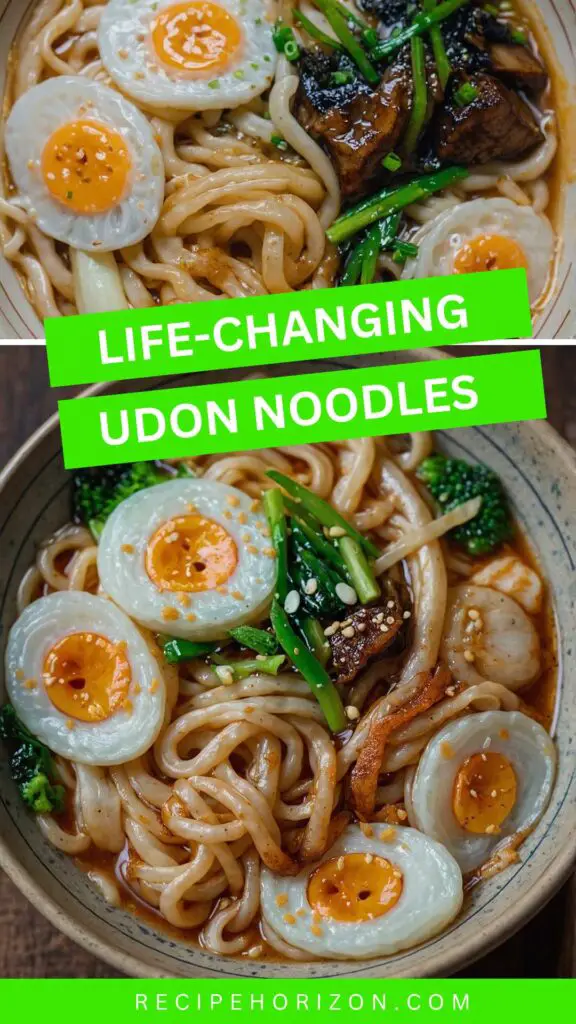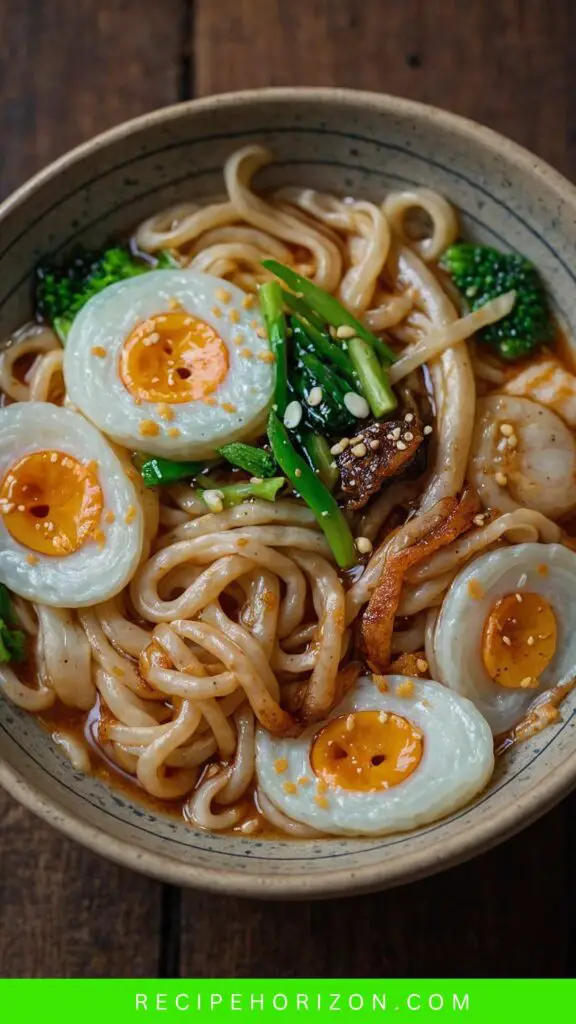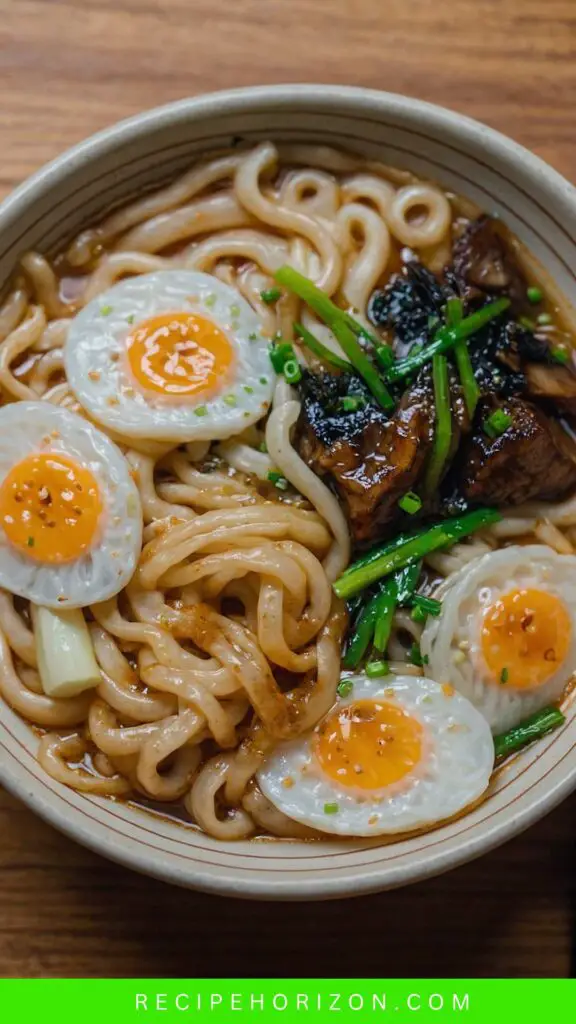When it comes to comfort food, a steaming bowl of udon noodles shines like a beacon. Deliciously thick, these Japanese wheat noodles are not just filling; they have a knack for transforming an ordinary meal into an extraordinary experience. First, let’s talk about what to pair these delightful noodles with.
You’ll Also Like These Recipes
- Grandmother’s Mustard Sauce
- Split Pea and Ham or Not Soup Recipe
- Oven Baked Polenta Miracle Poached Eggs Recipe
What Pairs Well with Udon Noodles?
- Fresh Vegetables: Crisp bell peppers, vibrant bok choy, or snap peas. They add both nutrition and a crunch that complements the noodles.
- Proteins: Grilled chicken or tofu brings a hearty touch. Shrimp is another excellent choice for seafood lovers.
- Broth: A warm vegetable or chicken broth acts as the perfect base. It seeps into the noodles, enhancing their flavor.
- Sauces and condiments: Soy sauce, mirin, and a touch of chili paste create a flavor explosion!
Let me take you through my own journey with life-changing udon noodles, a recipe I stumbled upon that utterly transformed the way I enjoy a simple bowl of noodles.

I first encountered udon noodles during a quest for a satisfying meal after a long day. You know, those days when the couch calls louder than the kitchen? The moment I took my first bite, I understood the magic.
These noodles are not only versatile and filling but also encourage creativity. With a few ingredients, you can whip up something that feels gourmet. As a registered dietitian and food enthusiast, I’m all about results that please the palate and nourish the body.
In this post, I’ll show you what life-changing udon noodles are, break down their flavor profile, and share why this recipe is a game changer. Get ready to elevate your noodle game!
What are Life-Changing Udon Noodles?
At their core, life-changing udon noodles are thick, chewy wheat noodles steeped in flavor. Unlike their thin relatives, these noodles hold sauces and broths beautifully. For me, they’re a reminder that food can not only sustain us but also bring joy.
What Do They Taste Like?
Imagine a warm embrace on a chilly day. Udon noodles have a delightfully mild flavor that pairs well with everything. When tossed with vegetable broth, soy sauce, and sesame oil, the noodles soak up every bit of richness and depth.
Each bite offers a blend of savory, slightly nutty, and comforting flavors. The softness of the noodles contrasts satisfying crunch from your chosen toppings. It’s a dish that sings to the senses.
Why This Recipe Works
Let’s dive into why this recipe is truly life-changing:
1. Simplicity at Its Best
The ingredients are straightforward and often found in your pantry. With just a few items like broth, soy sauce, and fresh greens, you can create a meal that feels elaborate but requires minimal effort.
2. Flexibility for All Diets
This recipe accommodates almost any dietary preference. You can make it vegetarian, gluten-free, or meat-heavy. This inclusive nature ensures everyone can savor the joy of udon.
3. Quick Cooking Time
In as little as 20 minutes, you can whip up a delicious bowl of udon noodles. Perfect for those busy nights when time is of the essence yet taste is essential.
4. Nutrient Boost
With the right toppings like greens, protein, and a splash of sesame oil, you’re not just enjoying noodles; you’re nourishing your body. It’s a delicious way to sneak in those vital nutrients.
Ingredients for Life-Changing Udon Noodles
Ready to get cooking? Here’s what you’ll need:
- 4 large free-range eggs
- 1.75 lbs (800 g) udon noodles
- 2 cups (500 ml) vegetable broth
- 3 to 4 tablespoons tamari or low-sodium soy sauce
- 2 teaspoons mirin
- 80 g (6 tbsp) unsalted butter, cubed (or adjust per bowl)
- 1 tablespoon toasted sesame oil, or to taste
- 4 scallions, thinly sliced on the bias
- 1/4 to 1/2 lb tender greens, such as baby bok choy or spinach (optional)
- 1 teaspoon grated ginger (optional, adds warmth and depth)
- 1 small clove garlic, minced (optional, enhances savory flavor)
- Sea salt and freshly ground black pepper, to taste
- Sambal Oelek or chili paste, optional for heat
Step-by-Step Instructions
Step 1: Boil the Noodles
Bring a large pot of salted water to a boil. Add the udon noodles and cook them according to package instructions, typically around 8-12 minutes. Once cooked, drain and rinse under cold water. This stops the cooking and prevents sticking.
Step 2: Prepare the Broth
In a separate saucepan, heat the vegetable broth over medium heat. Add the tamari, mirin, and if you’re using it, ginger and garlic. Stir it together to infuse the flavors.
Step 3: Cook the Eggs
While the broth warms, gently poach your eggs. Bring a small pot of water to a simmer, crack the eggs one at a time into cups, and slide it into the water. Cook them for about 3-4 minutes, ensuring that the whites are set but the yolks remain runny.
Step 4: Combine Everything
Add the cooked udon noodles to the broth. Stir in the butter, sesame oil, and scallions. Season generously with salt and pepper to taste. Allow everything to warm for another minute or so.
Step 5: Serve it Up
Ladle the udon noodle broth into bowls. Top with a poached egg and any additional toppings – be it the tender greens or a squeeze of chili paste. Enjoy immediately!

Notes
Here are some tips to ensure optimal noodle pleasure:
- Rinse the noodles: This helps remove excess starch and keeps them from clumping.
- Customize the broth: Experiment with adding miso paste for a richer flavor profile.
- Add crunch: Toasted sesame seeds or chopped nuts can add a delightful texture.
- Storage considerations: Store leftovers separately; undressed noodles keep better.
- Reheating: Warm gently in a pan with a bit of water to loosen the noodles.
Nutrition Information
Per serving (excluding optional toppings):
- Calories: 450
- Protein: 18 g
- Fat: 15 g
- Carbohydrates: 62 g
- Fiber: 3 g
- Sugar: 2 g

How to Store the Leftovers?
Store any leftover noodles in an airtight container in the fridge for up to 2 days. Make sure to separate the noodles from the broth to prevent them from getting too soggy. When you’re ready to enjoy them again, reheat the broth and add the noodles until warm.
Sides for Life-Changing Udon Noodles
Want to make it a feast? Consider adding these sides:
1. Asian Cucumber Salad
A refreshing cucumber salad complements the richness of the udon. Toss sliced cucumbers with rice vinegar, sesame oil, and chili flakes for a bright side.
2. Edamame
Steamed edamame offers a delightful pop of flavor. Simply sprinkle with sea salt, and you have a savory snack that pairs beautifully.
3. Vegetable Tempura
Crispy tempura vegetables add a lovely crunch. The light batter keeps it from overpowering your noodles.
4. Miso Soup
A small mug of warm miso soup is like a comforting hug. Its umami flavor enhances the entire meal.
Alternative Choices for Ingredients
Not every kitchen is stocked to the brim. If you’re missing an item, consider these choices:
1. Noodles: If udon noodles aren’t available, substitute with soba or even spaghetti for a different texture, but immerse yourself in a similar experience.
2. Broth: Chicken or pork broth can replace vegetable broth for non-vegetarians, enriching the umami experience.
3. Soy Sauce: Coconut aminos serve as a fantastic gluten-free option while delivering a similar taste.
4. Greens: Kale or Swiss chard can stand in for bok choy and add a different profile while maintaining nutrition.
Life-Changing Udon Noodles
Ingredients
Equipment
Method
- Bring a large pot of salted water to a boil. Add the udon noodles and cook them according to package instructions, typically around 8-12 minutes. Once cooked, drain and rinse under cold water. This stops the cooking and prevents sticking.
- In a separate saucepan, heat the vegetable broth over medium heat. Add the tamari, mirin, and if you’re using it, ginger and garlic. Stir it together to infuse the flavors.
- While the broth warms, gently poach your eggs. Bring a small pot of water to a simmer, crack the eggs one at a time into cups, and slide it into the water. Cook them for about 3-4 minutes, ensuring that the whites are set but the yolks remain runny.
- Add the cooked udon noodles to the broth. Stir in the butter, sesame oil, and scallions. Season generously with salt and pepper to taste. Allow everything to warm for another minute or so.
- Ladle the udon noodle broth into bowls. Top with a poached egg and any additional toppings – be it the tender greens or a squeeze of chili paste. Enjoy immediately!
Nutrition
Notes
- Rinse the noodles: This helps remove excess starch and keeps them from clumping.
- Customize the broth: Experiment with adding miso paste for a richer flavor profile.
- Add crunch: Toasted sesame seeds or chopped nuts can add a delightful texture.
- Storage considerations: Store leftovers separately; undressed noodles keep better.
- Reheating: Warm gently in a pan with a bit of water to loosen the noodles.
Tried this recipe?
Let us know how it was!Frequently Asked Questions
1. Can I make this dish vegan?
Absolutely! To make it vegan, simply omit the eggs and substitute butter with olive oil or vegan butter. Ensure your broth is veggie-based, and you’re good to go!
2. Can I prepare this dish in advance?
You can somewhat prep in advance by cooking the noodles and storing them separately. However, avoid combining the broth until just before eating to maintain freshness.
3. What can I do with leftover broth?
Leftover broth is excellent for soups or can be used as a base for gravies. You can even freeze it in ice cube trays for quick flavor hits in future dishes.
4. How do I make the broth more flavorful?
To amp up the flavor, try adding a piece of kombu seaweed during the warming process, or throw in mushrooms to create a more complex broth.
Conclusion
So there you have it; life-changing udon noodles are not just a meal, they’re an experience. From their rich texture to the comforting broth, this dish has everything you want in comforting food. Whether you’re cooking for family, friends, or just treating yourself, this recipe is sure to impress.
With a little practice and experimentation, you and your noodles can truly grow together. As you dive into this warm, satisfying bowl, you’ll realize that sometimes, the simplest ingredients lead to the most profound moments of joy. Grab your ingredients, and let’s make magic in the kitchen!




